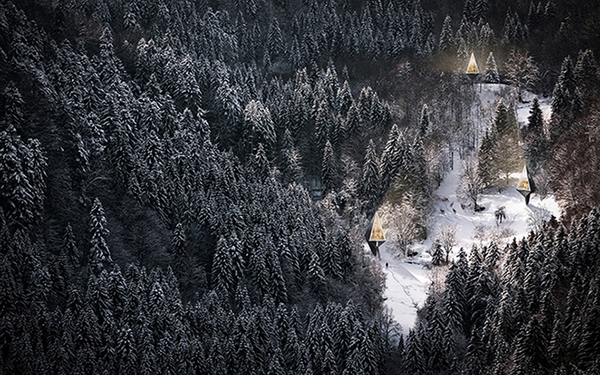
Danish architecture student Konrad Wójcik has come up with a very modern and unique way for people to live in the suburbs of large cities, with minimal impact on the natural habitat. At the heart of his so-called “Primeval Symbiosis” plan are tree shaped houses that have a tiny footprint and very little environmental impact on the forests where they could be built. In his design, he drew inspiration from trees and the way animals use them as shelters. His tree houses are powered by renewable energy, while they also fertilize soil, clean the air, provide shade, and have natural ventilation.

The houses Wójcik proposes are pine shaped and stand on a tree trunk-like pillar high above the ground. One side of such a house would be covered in solar panels to produce all the needed power for the home. The homes would also be equipped with a heat pump, which takes in energy from the ground. The planned houses would also be fitted with a bio-digester, which would turn waste on site into even more energy. The pine shaped living area would also be fitted with large windows to let in huge amounts of natural light and minimize the need for electric light, as well as let in plenty of fresh air.

The frame of the homes Wójcik proposes would be built solely from wood, engineered in a way to be able to support the entire house. Since his main goal was sustainable and environmentally friendly design, he decided to not use any steel or cement in the construction process. The timber pole used to support the house and raise it above the ground would be able to bear the entire weight of the house. The entire home can also be recycled once it is no longer needed.


Each of Wójcik’s houses would be comprised of four tiny floors and is designed to be occupied by two people, though up to four occupants could fit inside. The interior of the home, such as furniture and walls, would be constructed from reusable materials. While the tiny houses would make for great vacation homes, they could also serve as regular homes for environmentally conscious individuals.
Part of Wójcik’s novel plan is to locate these homes in forests near big cities, so that they could form a sort of sustainable suburb. He imagines the homes to be placed in the forests with enough distance between the units to give the occupants a sense of privacy. According to Wójcik, the biggest challenge to building a community of such houses is not the engineering, but finding a way to fit all the needed sustainability features onto such a small space. He’s currently looking for a developer to help him bring his vision to life.
Related Articles on JetsonGreen.com:
Grain Silos Are a Great Alternative to Shipping Container Homes
Tiny Homes For The Wisconsin Homeless
AIR House Connects Inhabitants with Nature in Simple, Sustainable Style

Leave a Reply
You must be logged in to post a comment.